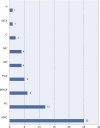Diagnostic and treatment challenges in traumatic brain injury patients with severe neuropsychiatric symptoms: insights into psychiatric practice
- PMID: 26170672
- PMCID: PMC4494623
- DOI: 10.2147/NDT.S80457
Diagnostic and treatment challenges in traumatic brain injury patients with severe neuropsychiatric symptoms: insights into psychiatric practice
Abstract
Traumatic brain injury (TBI) causes a variety of neuropsychiatric problems that pose diagnostic and treatment challenges for providers. In this report, we share our experience as a referral neuropsychiatry program to assist the general psychiatrist when adult TBI patients with psychiatric symptoms present for evaluation and treatment. We completed a retrospective study of patients with moderate-to-severe TBI and severe neuropsychiatric impairments. We collected information on demographics, nature of injury, symptomatology, diagnoses, and treatments. Data analysis indicates that mood stabilization was a key concern, often requiring aggressive pharmacological management. Cognitive dysfunction was a problem for the majority of patients, but was only medicated in a third, due to poor efficacy or behavioral side effects. The co-occurrence of multiple TBI-related symptoms and diagnoses in this patient cohort emphasizes the need for individualized psychopharmacological approaches and interventions.
Keywords: neurobehavioral; traumatic brain injury; treatment.
Figures
References
-
- Faul M, Xu L, Wald M, et al. Traumatic Brain Injury in the United States: Emergency Department Visits, Hospitalizations and Deaths 2002–2006. Atlanta, GA: Centers for Disease Control and Prevention, National Center for Injury Prevention and Control; 2010.
-
- Fann JR, Burington B, Leonetti A, Jaffe K, Katon WJ, Thompson RS. Psychiatric illness following traumatic brain injury in an adult health maintenance organization population. Arch Gen Psychiatry. 2004;61(1):53–61. - PubMed
-
- Deb S, Lyons I, Koutzoukis C, Ali I, McCarthy G. Rate of psychiatric illness 1 year after traumatic brain injury. Am J Psychiatry. 1999;156(3):374–378. - PubMed
-
- Hibbard MR, Uysal S, Kepler K, Bogdany J, Silver J. Axis I psychopathology in individuals with traumatic brain injury. J Head Trauma Rehabil. 1998;13(4):24–39. - PubMed
-
- Koponen S, Taiminen T, Portin R, et al. Axis I and II psychiatric disorders after traumatic brain injury: a 30-year follow-up study. Am J Psychiatry. 2002;159(8):1315–1321. - PubMed
LinkOut - more resources
Full Text Sources




